Posted by Elena del Valle on April 30, 2010

The Public Communication Division of the School of Communication at American University is seeking candidates to fill a full-time temporary faculty position at the rank of Assistant Professor, to begin Fall 2010. Applicants should be able to teach professional and/or theory-based courses, both undergraduate and graduate, in public relations or related communication fields.
Click here for the full text of SOC Public Communication Temporary Faculty Search
Posted by Elena del Valle on April 30, 2010
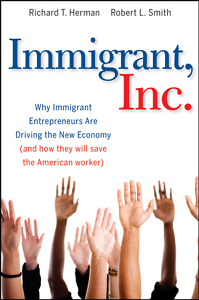
Immigrant, Inc. Why Immigrant Entrepreneurs Are Driving the New Economy
Photos: John Wiley & Sons, Inc.
Myriad uber famous companies were founded by immigrants to the United States. Examples include Google, Intel, Yahoo, Hotmail, YouTube, Sun Microsystems and ebay. In 2010, immigrants in the United States are almost twice as likely as non immigrants to establish a business. Immigrants are behind more than half the new high tech businesses in Silicon Valle; and they are more likely to earn an advanced degree, receive a patent or create an invention, according to the authors of a newly published book.
Richard T. Herman and Robert L. Smith point out that amidst all the controversy over undocumented immigrants many people overlook the critical contributions of legal immigrants to America’s business environment and economy. The immigration and business law attorney and journalist specializing in immigration issues, both Ohio residents, authored Immigrant, Inc. Why Immigrant Entrepreneurs Are Driving the New Economy (and how they will save the American worker) (Wiley, $29.95), a 226-page hardcover book about the importance and accomplishments of immigrants published in 2010.
They believe some immigrants arrive primed with ambition, education, thrifty attitudes, and family loyalty to launch their entrepreneurial dreams and find success. In turn they create businesses and jobs that fuel our economy and help our country thrive at a noteworthy rate.
The authors dedicated 10 chapters to the topic, exploring the motivations and qualifications of immigrants and examining individual immigrant’s stories. The chapters are: A Mighty New Idea; The Mounting Evidence; A Land of Opportunity, Still; Restless Dreamers; Earth’s Best and Brightest; Cowboys of a New Frontier; Desperate Achievers: Prequel to Google; Importing Solutions; The Stimulus We Need; and Thinking Like an Immigrant.

Co-author Richard T. Herman

Co-author Robert L. Smith
Herman is the founder of Richard T. Herman and Associates, an immigration and business law firm in Cleveland, Ohio. He is also the co-founder of a chapter of TiE, a global network of entrepreneurs. Smith writes about international culture and immigration for The Plain Dealer, one of the largest newspapers in Ohio.

Click here to buy Immigrant, Inc.
Comments:
Filed Under: Books
Posted by Elena del Valle on April 28, 2010
By Astrid Rial
President, Arial International
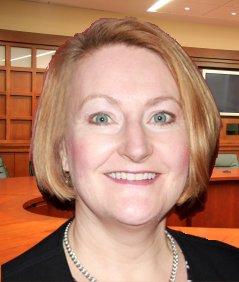
Astrid Rial, president, Arial International
Photo: Arial International
Companies who recruit bilingual talent to service Spanish-speaking customers seek associates who can effectively communicate in both English and Spanish. In the last few years we have observed that many more companies in the U.S. are providing additional compensation in the form of a bilingual premium or differential to bilingual associates.
Many Spanish speakers in the US speak colloquial or familiar Spanish, so the challenge for recruiters is to objectively verify that bilingual job candidates are able to competently communicate in professional and appropriate Spanish for business situations. Unless an interviewer is fully fluent in both languages, it is difficult, if not impossible, to distinguish between casual and business Spanish.
Click here to read the complete article Recruiting and Remunerating Spanish Speakers
Posted by Elena del Valle on April 26, 2010
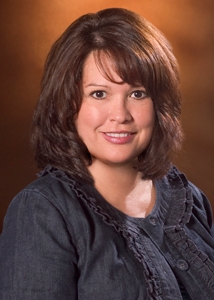
Bilda Acuña, vice president, Unum Hispanic initiative
Photo, video: Unum
Unum, a provider of employee benefits products and services in the United States and United Kingdom, decided recently to offer Spanish dominant Hispanic customers information, in Spanish online and on DVD, about some of its offerings. Last month, the company which has 12 million customers, including 240,000 Spanish speakers, in the United States, announced a series of educational videos in Spanish about its employee benefits products and services.
This is the first time the insurer produces informational videos for customers in a foreign language in the United States. Additional videos are planned for new products. Scroll down to watch a sample 3.5 minute Spanish language video.
“Instead of a literal translation of existing materials, we’re starting fresh so we can be more relevant to the Hispanic demographic. The Hispanic population is growing faster than any other ethnic minority,” said Bilda Acuña, assistant vice president of Unum’s Hispanic initiative.
Citing Pew Research Center data estimating that within two decades, the Hispanic share of the workforce will more than double to 31 percent; and the company’s belief that Hispanic employees are not always familiar with insurance products because the benefits were not offered in their country of origin, they believe they are a luxury product or that the benefits are provided by the government the company decided to create a collection of materials for Spanish-speaking customers.
Toward this goal Unum dedicated nine staff members, nine months and an undisclosed budget to the production of the new visual materials in Miami, Florida. The videos, available on DVD and online, will be used during enrollment times when employees learn and sign up for their workplace benefits. These are the first videos Unum has produced in Spanish.
“One quarter of Unum’s customers have Spanish-speaking employees, and it is important for us to create a benefits education approach that is as relevant and effective as possible, especially for this expanding demographic group,” said Acuña. “Many insurance companies are making an effort to reach the Hispanic market, but Unum is unique in that we are creating our pieces from scratch. Instead of a literal translation of existing materials, we’re starting fresh so we can be more relevant to the Hispanic demographic.”
Unum hired Marca, a Miami-based advertising agency company that specializes in Hispanic marketing, to assist with the production of the 11-video series designed in easy-to-understand terms. The videos feature Unum’s core products: group and voluntary life insurance; group and individual short term disability insurance; group long term disability insurance; and supplemental insurance, including Accident, Critical Illness and Cancer Insurance.
The videos are the company’s latest effort to target Spanish dominant Hispanics. Over the past year, Unum has directed some efforts to customer service for Spanish-speaking consumers such as: increasing the number of bilingual benefits counselors across the country to help customers enroll in Unum’s products and services; interviewing 86 percent of Spanish-speaking employees in their preferred language; and adding a bilingual benefits team in California to handle claims for Hispanic customers. One hundred Hispanics are employed at Unum.
Comments:
Filed Under: Video
Posted by Elena del Valle on April 23, 2010

PR Therapy book cover
Photos: Quill Driver Books
In PR Therapy: Ignite Your Passion for Promoting Your Products, Services, and Even Yourself! Robin Blakely, a New York City public relations consultant, dedicates 180 pages to help readers build a public relations platform for their businesses. She focuses on print, broadcast and live media options.
In the book, she examines basic issues like the need to make changes in existing patterns of behavior, identifying assets and liabilities of the person or brand to be promoted, options available, and narrowing the target audience for starters. She shares suggestions, based on her experiences and that of colleagues, readers may want to consider to address the challenges they face along the way to promoting their business and brand.
The softcover book, published last year, is divided into six section she calls phases: Your Big Couch Trip, The RX to Analyze Your Audience, Picking and Approaching the Media, Your PR Empowerment Tools, The Media and Doing What It Takes, and Building on Your Success. These in turn are divided into what she calls sessions.
Blakely promises readers will have the tools to visualize and build a promotional base that allows them to connect with the most important areas of their market, select varied media venues to target, design the right tools for their business, understand what they need to know before beginning their promotional efforts in earnest.

A ten-year veteran in her field, Blakely is the founder of Livingston Communications, Inc. and a founding partner of Get There Media, a New York City company. She has secured promotional placements for clients at print, broadcast and live venues with HGTV, Book TV, ABC World News, and Vanity Fair among others.

Click here to buy PR Therapy
Comments:
Filed Under: Books
Posted by Elena del Valle on April 22, 2010
Information provided by our Event Partner
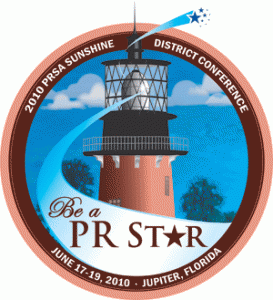
Pack your business cards and bathing suits and get ready to Be a PR Star!
The 2010 Sunshine District Conference is just around the corner. Register Today!!
Conference attendees will learn today’s premier communications techniques from leaders in the profession while getting a taste of the Palm Beach’s rich history and culture. Workshops will focus on a variety of topics, including advancements in social media, crisis communications, ethics and law, web marketing, and earning your accreditation.
If you want to stroll on the beach while learning the best skills, then Be a PR STAR at the 2010 PRSA Sunshine District Conference.
WHEN: Thursday-Saturday, June 17-19, 2010
WHERE: Right on the beach – at the Jupiter Beach Resort & Spa, Jupiter, Fla.
WHY: Situated along one of the richest coastlines in the country, Jupiter is steep in history from the pirates of the 1700s to the local celebrities who call it their home. You’ll be steps away from the shoreline and the treasures of the ocean while learning from nationally-renown speakers and experts in the profession.
Attendees: The PRSA Sunshine District Conference is hosted annually by one of the District’s seven chapters. Though hosted by a PRSA chapter, membership is not required to attend, and in fact, conferences typically include representation from numerous communications groups, including IABC, FPRA, AIGA, and Ad Federations. Approximately 125 to 150 public relations professionals are expected to attend.
Visit http://prsapalmbeach.org/meetinginfo.php?id=5
Posted by Elena del Valle on April 21, 2010
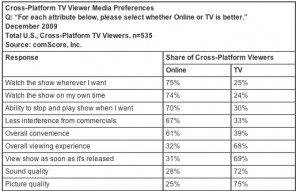
Click on image to enlarge
Photo, chart: comScore
According to a study released last month, people who watch television online are young (54 percent are 35 years old and under), likely to watch programs where and when they choose and more tolerant of ads than regular television viewers. Study participants were asked questions designed to assess their tolerance of advertising (based on one minute increments from 0-15 minutes) when watching one hour of TV programming on the Internet. Analysts determined the highest tolerance for online TV watchers was between six and seven minutes per hour which is much higher than the four minutes per hour of ads delivered online as part of TV content.
Although survey respondents thought sound and picture quality were better on television, most participants in the study, 75 percent, said they choose to watch TV programming online because it is possible to watch it wherever they want (within the United States as many televisions programs are not available online in foreign countries); 74 percent said they do so because they can watch the shows whenever they want; 70 percent preferred watching television programs online because of the stop and play option; and 67 because there is less commercial interference.

Tania Yuki, director, online video and cross-platform product at comScore
“As cross-platform TV viewing becomes more widely adopted, it is important to understand the driving forces behind this shift in consumer behavior if we are to effectively monetize this emerging medium,” said Tania Yuki, comScore director of online video and cross-platform product, in a press release. “While some analysts have suggested that the shift to online video reflects a consumer desire to view fewer ads, our research suggests that in many cases online TV viewers actually have a higher tolerance for advertising messages than they are currently receiving. This finding, of course, suggests there’s advertising revenue being left on the table and that media companies have not yet extracted full value out of the online medium.”
Young TV viewers among the survey respondents said they are most likely to watch television programs at the time of their choosing; only 35 percent of viewers age 18-24 (25-34 year olds behaved similarly) said they watched episodes live; 42 percent said they watched programs at a different time within one week of the original air date and 23 percent said they watched the programs more than one week after the original air date.
Researchers in the comScore study distinguished three segments of television programming viewers. Those who only watched television, TV-only viewers, (65 percent); those that watched television programs on television and online, cross-platform viewers (29 percent); and those who watched televisions programs only online, online-only viewers (6 percent). Study analysts compared the attitude differences between the three groups. The study, based on a survey of more than 1,800 U.S. Internet users who watch originally scripted TV content, was first presented by Tania Yuki at the ARF Re:think conference on March 23, 2010.
According to a comScore spokesperson the study did not include ethnic profiling. However, independent data suggests Hispanics skew young as a demographic group and over index in the use of the internet, making it possible, even likely, the findings of the study apply to Hispanics who watch television programs online.
Posted by Elena del Valle on April 19, 2010
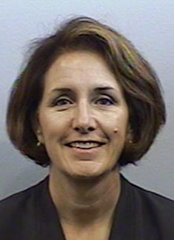
Teresa Iglesias-Solomon, vice president, Multicultural and Latino Initiatives, Best Buy
Photo: Best Buy
A podcast interview with Teresa Iglesias-Solomon, vice president, Multicultural and Latino Initiatives, Best Buy is available in the Podcast Section of Hispanic Marketing & Public Relations, HispanicMPR.com. During the podcast, she discusses issues relating to marketing to Latinos with Elena del Valle, host of the HispanicMPR.com podcast.
Teresa leads strategies relative to serving diverse customers, with an emphasis on Hispanic communities. Her cross-functional team is responsible for gaining deep understanding of different cultures, and translating that insight into respectful and meaningful relationships in the company stores, online and in their communities.
Teresa, a 20-year industry veteran and native Latina who has lived and worked in Mexico and the United States, joined Best Buy in 2007. Prior to working with the national retail company, she led marketing efforts targeted to the U.S. Hispanic market for Domino’s Pizza where she established the company’s first-ever Hispanic Advisory Council and launched a national Hispanic campaign tied to the World Cup. She also has worked for Accu Bite Dental, Kellogg Company and Lever Brothers where she launched the first national campaign for Close-Up toothpaste targeting the Hispanic market in the United States.
Teresa earned her master’s in business administration from Stanford University in 1986. She serves on the board of directors for Amcore Bank, a regional chain with locations in Wisconsin and Illinois; and is a member of Latinos Unidos, a non-profit organization serving the Latino community in Ann Arbor, Michigan.
To listen to the interview, scroll down until you see “Podcast” on the right hand side, then select “HMPR Teresa Iglesias-Solomon” click on the play button below or download the MP3 file to your iPod or MP3 player to listen on the go, in your car or at home. To download it, click on the arrow of the recording you wish to copy and save it to disk. The podcast will remain listed in the April 2010 section of the podcast archive.
Posted by Elena del Valle on April 16, 2010
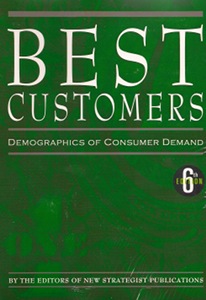
Best Customers: Demographics of Consumer Demand
Did you know that on average Asian households in America spend more than non Hispanic white households? And that black and Hispanic households spend less? At the same time, there are wide variations in some spending habits by ethnic groups. For example, Asian households spend very little on pets while blacks and Hispanics spend significantly more than other groups for children’s clothes.
Marketers wanting to prepare for trends such as the Baby Boomer generation and the rise of ethnic emerging markets like the Asian, black and Hispanic segments, which are estimated to account for one of every five dollars of purchases in America, may be interested in the detailed information about the products and services consumers bought in past years outlined in Best Customers: Demographics of Consumer Demand (New Strategist Publications, $89.95).
The 775-page softcover book breaks down purchases and spending patterns by the demographic characteristics of households based on data from the Bureau of Labor Statistics’ 2007 Consumer Expenditure Survey. The source of the previously unpublished data is surveys of household spending. The time lag between the data collection and the publication of the book, 2009, is about two years.
The book is divided into 21 chapters (in alphabetical order): Alcohol, Apparel, Computers, Education, Entertainment, Financial Products and Services, Furnishings and Equipment, Gifts for People in Other Households, Groceries, Health Care, Reading Material, Restaurants and Carry-Outs, Shelter, Telephone, Tobacco Products, Transportation, Travel and Utilities; and four appendices: About the Consumer Expenditure Survey; Percent Reporting Expenditure and Amount Spent, Average Quarter 2007; Spending by Product and Service, Ranked by Amount Spent, 2007; and Annual Average Household Spending, 2000 and 2007.
The information in the book was originally gathered by the Census Bureau to allow the federal government to track prices. Two groups of 7,000 households (technically called consumer units) each in 91 areas of the country provide the data through two different surveys which are thought to cover 95 percent of expenditures. It is not clear if undocumented residents are included in the survey. Other sources of similar data collection indicate the Consumer Report Survey data is lower than actual except for: rent, fuel, telephone service, furniture, transportation and personal care services.
New Strategist Publications publishes other demographic data titles about consumers (see Book outlines spending by race, ethnic group and New York publisher shares household spending summary) and Hispanics (see Data rich book outlines Hispanic market profile).

Click here to buy Best Customers
Comments:
Filed Under: Books
Posted by Elena del Valle on April 15, 2010
Information provided by our Event Partner

Search Engine Strategies Toronto Conference & Expo – June 9-11
From social media to local search to video optimization, Search Engine Strategies Toronto puts you in front of the experts who will help you sort which technologies and channels will take you to the next level and which are just hype. Deep dive into emerging trends which will shape 2010 and beyond.
Search can put you in control with more measurable results, targeted reach, and constant visibility than traditional marketing. So start making decisions based on the facts and learn how to increase conversions with consistent returns. Register by May 21 and SAVE up to $200 on a platinum pass. Enter 20SMC to SAVE an additional 15% off the current rate.
Sessions include:
- Video: The Next Marketing Frontier
- Augmented Reality: A New World Order
- 21 Secrets of Top Converting Websites
- Integrating Social Media & Search to Drive Brand
- Canada-Specific SEO & PPC Issues
Keynotes
Peter Morville, President, Semantic Studios
Maile Ohye, Senior Developer Programs Engineer, Google
Visit http://www.searchenginestrategies.com/toronto/?code=15mpr&utm_source=hispanicmpr


























